From Wikipedia"
Translate
Wednesday, May 30, 2012
Type 039 Song Class attack submarine
From Wikipedia"
Tuesday, May 29, 2012
F/A - D Hornet "Night Attack" Composite
Here is my composite image of Academy's 1/32 scale McDonnell Douglas F/A - D Hornet "Night Attack" two seat fighter flying over desert like terrain.
Images of the model can be seen here.
Versatile Blogger

I guess I've been nominated for the "Versatile Blogger Award".
So a big hardy thanks to "Spacerguy" for the nomination. If you're a Star Trek fan he has a great site so check him out.
It's always an honor to be nominated for ones work regardless whether one wins or not.
Monday, May 28, 2012
Mitsubishi A6M-5 Model 52 Type 0 Composite
Images of the model cane be seen here.
de Havilland DH. 82 C Tiger Moth Composite
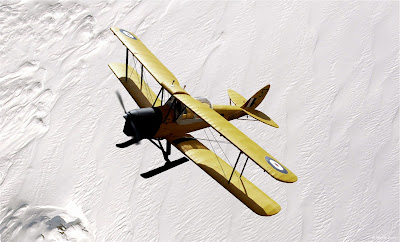
Here is my composite image of Revell's 1/32 scale de Havilland DH. 82 C Tiger Moth (Matchbox molds) rising from a snowy landscape.
Images of the model can be seen here.
Sunday, May 27, 2012
de Havilland DH. 82 C Tiger Moth

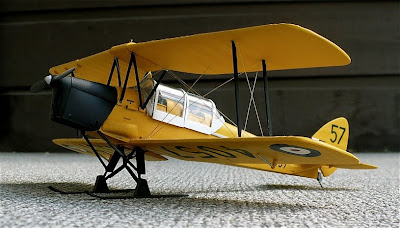

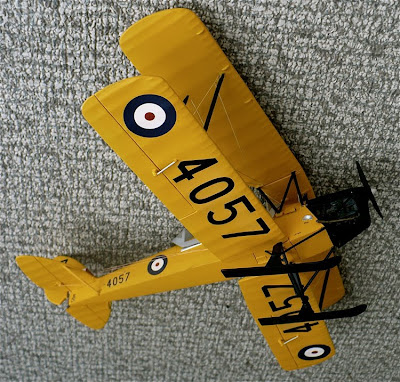


Here are some images of Revell's 1/32 scale de Havilland DH. 82 C Tiger Moth (Matchbox molds). This aircraft has the markings of 4057 No. 6 elementary flying training school, RCAF, Prince Albert Saskatchewan 1940. The Tiger Moth was one of the primary trainers during World War Two and was used as a trainer for the RAF until 1952 when they were released to the civilian market. Many flying examples of this aircraft can be seen to this day. This is one of the great Matchbox kits from the 1970s and thankfully is still available to this day. At around $30 Cdn this kit is a great buy.
From Wikipedia"
Saturday, May 26, 2012
Lunar Module Composite
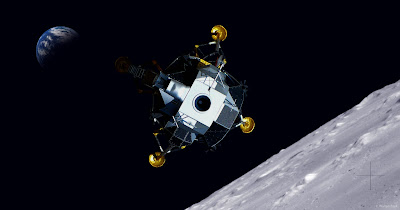
Here is my composite image of Dragon's 1/48 scale Grumman LM (Lunar Module) Eagle used in the Apollo 11 landing in its natural environment.
Images of the model can be seen here.
Friday, May 25, 2012
Lunar Module





Here are some images of Dragon's 1/48 scale Grumman LM (Lunar Module) Eagle used in the Apollo 11 landing.
From Wikipedia"
The Apollo Lunar Module (LM), also known as the Lunar Excursion Module (LEM), was the lander portion of the Apollo spacecraft built for the US Apollo program by Grumman to carry a crew of two from lunar orbit to the surface and back. Six such craft successfully landed on the Moon between 1969–1972.
The LM, consisting of an Ascent stage and Descent stage, was ferried to lunar orbit by its companion Command/Service Module (CSM), a separate spacecraft of approximately twice its mass, which took the astronauts home to Earth. After completing its mission, the LM was discarded. In one sense it was the world's first true spacecraft in that it was capable of operation only in outer space, structurally and aerodynamically incapable of flight through the Earth's atmosphere.
The LM got a later start on its design than the CSM, due to the initial unpopularity of the lunar orbit rendezvous strategy. Its development was also plagued with several hurdles which delayed its first unmanned flight by about ten months, and its first manned flight by about three months. Despite this, the LM eventually became the most reliable component of the Apollo/Saturn system, the only one never to suffer any failure that significantly impacted a mission,[1] and in at least one instance (LM-7 Aquarius) greatly exceeded its design requirements by maintaining life support for astronauts after an explosion damaged the Apollo Service Module.
Lunar Modules produced
| Serial number | Name | Use | Launch date | Current location | |
|---|---|---|---|---|---|
| LM-1 | Apollo 5 | January 22, 1968 | Reentered Earth's atmosphere | ||
| LM-2 | Intended for second unmanned flight; not used | On display at the National Air and Space Museum, Washington, DC | |||
| LM-3 | Spider | Apollo 9 | March 3, 1969 | Reentered Earth's atmosphere | |
| LM-4 | Snoopy | Apollo 10 | May 18, 1969 | Descent stage impacted Moon; Ascent stage in solar orbit. Snoopy is the only surviving flown LM ascent stage. | |
| LM-5 | Eagle | Apollo 11 | July 16, 1969 | Descent stage on lunar surface; Ascent stage left in lunar orbit (orbit decayed: impact location on moon unknown) | |
| LM-6 | Intrepid | Apollo 12 | November 14, 1969 | Descent stage on lunar surface; Ascent stage deliberately crashed into Moon | |
| LM-7 | Aquarius | Apollo 13 | April 11, 1970 | Reentered Earth's atmosphere | |
| LM-8 | Antares | Apollo 14 | January 31, 1971 | Descent stage on lunar surface; Ascent stage deliberately crashed into Moon | |
| LM-9 | Not flown (originally intended as Apollo 15, last H-class mission) | On display at the Kennedy Space Center (Apollo/Saturn V Center) | |||
| LM-10 | Falcon | Apollo 15, first ELM | July 26, 1971 | Descent stage on lunar surface; Ascent stage deliberately crashed into Moon | |
| LM-11 | Orion | Apollo 16 | April 16, 1972 | Descent stage on lunar surface; Ascent stage left in lunar orbit, eventually crashed on Moon | |
| LM-12 | Challenger | Apollo 17 | December 7, 1972 | Descent stage on lunar surface; Ascent stage deliberately crashed into Moon | |
| LM-13 | Not flown (originally intended as Apollo 18)[11] | Partially completed by Grumman; restored and on display at Cradle of Aviation Museum, Long Island, New York. Also used during HBO's 1998 mini-series From the Earth to the Moon. | |||
| LM-14 | Not flown (originally intended as Apollo 19) | Never completed; unconfirmed reports claim that some parts (in addition to parts from test vehicle LTA-3) are included in LM on display at the Franklin Institute, Philadelphia (see Franklin Institute web page.) | |||
| LM-15 | Not flown (might have been Apollo Telescope Mount) | Scrapped | |||
Thursday, May 24, 2012
F/A - D Hornet "Night Attack"






Here are some images of Academy's 1/32 scale McDonnell Douglas F/A - D Hornet "Night Attack" two seat fighter.
From Wikipedia"
The McDonnell Douglas (now Boeing) F/A-18 Hornet is a twin-engine supersonic, all-weather carrier-capable multirole fighter jet, designed to dogfight and attack ground targets (F/A for Fighter/Attack). Designed by McDonnell Douglas and Northrop, the F/A-18 was derived from the latter's YF-17 in the 1970s for use by the United States Navy and Marine Corps. The Hornet is also used by the air forces of several other nations. It has been the aerial demonstration aircraft for the U.S. Navy's Flight Demonstration Squadron, the Blue Angels, since 1986.
The F/A-18 has a top speed of Mach 1.8. It can carry a wide variety of bombs and missiles, including air-to-air and air-to-ground, supplemented by the 20 mm M61 Vulcan cannon. It is powered by two General Electric F404 turbofan engines, which give the aircraft a high thrust-to-weight ratio. The F/A-18 has excellent aerodynamic characteristics, primarily attributed to its leading edge extensions (LEX). The fighter's primary missions are fighter escort, fleet air defense, Suppression of Enemy Air Defenses (SEAD), air interdiction, close air support and aerial reconnaissance. Its versatility and reliability have proven it to be a valuable carrier asset, though it has been criticized for its lack of range and payload compared to its earlier contemporaries, such as the Grumman F-14 Tomcat in the fighter and strike fighter role, and the Grumman A-6 Intruder and LTV A-7 Corsair II in the attack role.
The F/A-18 Hornet provided the baseline design for the Boeing F/A-18E/F Super Hornet, a larger, evolutionary redesign of the F/A-18. Compared to the Hornet, the Super Hornet is larger, heavier and has improved range and payload. The F/A-18E/F was originally proposed as an alternative to an all-new aircraft to replace existing dedicated attack aircraft such as the A-6. The larger variant was also directed to replace the aging F-14 Tomcat, thus serving a complementary role with Hornets in the U.S. Navy, and serving a wider range of roles including refueling tanker. The Boeing EA-18G Growler electronic jamming platform was also developed from the F/A-18E/F Super Hornet.
The F/A-18C is the single-seat variant and the F/A-18D is the two-seat variant. The D-model can be configured for training or as an all-weather strike craft. The "missionized" D model's rear seat is configured for a Marine Corps Naval Flight Officer who functions as a Weapons and Sensors Officer to assist in operating the weapons systems. The F/A-18D is primarily operated by the U.S. Marine Corps in the night attack and FAC(A) (Forward Air Controller (Airborne)) roles.
The F/A-18C and D models are the result of a block upgrade in 1987 incorporating upgraded radar, avionics, and the capacity to carry new missiles such as the AIM-120 AMRAAM air-to-air missile and AGM-65 Maverick and AGM-84 Harpoon air-to-surface missiles. Other upgrades include the Martin-Baker NACES (Navy Aircrew Common Ejection Seat), and a self-protection jammer. A synthetic aperture ground mapping radar enables the pilot to locate targets in poor visibility conditions. C and D models delivered since 1989 also have improved night attack abilities, consisting of the Hughes AN/AAR-50 thermal navigation pod, the Loral AN/AAS-38 NITE Hawk FLIR (forward looking infrared array) targeting pod, night vision goggles, and two full-color (formerly monochrome) multi-function display (MFDs) and a color moving map.
In addition, 60 D-model Hornets are configured as the night attack F/A-18D (RC) with ability for reconnaissance. These could be outfitted with the ATARS electro-optical sensor package that includes a sensor pod and equipment mounted in the place of the M61 cannon.
Beginning in 1992, the F404-GE-402 enhanced performance engine, providing approximately 10% more maximum static thrust became the standard Hornet engine. Since 1993, the AAS-38A NITE Hawk added a designator/ranger laser, allowing it to self-mark targets. The later AAS-38B added the ability to strike targets designated by lasers from other aircraft.
Production of the F/A-18C ended in 1999. In 2000, the last F/A-18D was delivered to the U.S. Marine Corps.Wednesday, May 23, 2012
U.S.A.A. Space Clipper Composite

Here is my composite image of Mobius Model's 1/160 Orion III Space Clipper (Yes I know another one) in U.S.A.A (United States Astronautical Agency) markings.
The U.S.A.A. was the 2001 a space odyssey universe equivalent of N.A.S.A.
Images of the model can be seen here.
Monday, May 21, 2012
Sunday, May 20, 2012
Pictures of Home Pt 3
Saturday, May 19, 2012
Friday, May 18, 2012
Mitsubishi A6M-5 Model 52 Type 0

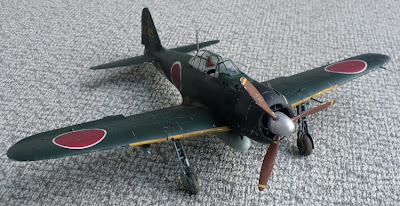

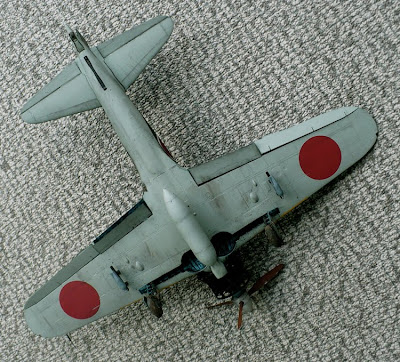
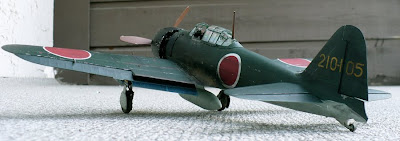
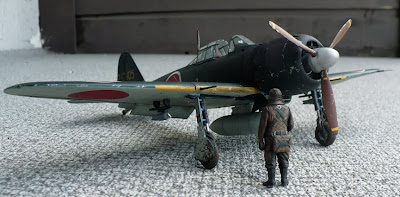
Here are some images of Tamiya's 1/32 scale Mitsubishi A6M-5 Model 52 Type 0.
From Wikipedia"
Considered the most effective variant, the Model 52 was developed to face the powerful American F6F Hellcat and F4U Corsair, superior mostly for engine power and armament. The variant was a modest update of the A6M3 Model 22, with non-folding wing tips and thicker wing skinning to permit faster diving speeds, plus an improved exhaust system. The latter used four ejector exhaust stacks, providing an increment of thrust, projecting along each side of the forward fuselage. The new exhaust system required modified "notched" cowl flaps and small rectangular plates which were riveted to the fuselage, just aft of the exhausts. Two smaller exhaust stacks exited via small cowling flaps immediately forward of and just below each of the wing leading edges. The improved roll-rate of the clipped-wing A6M3 was now built in.
Sub-variants included:
- "A6M5a Model 52a «Kou»," featuring Type 99-II cannon with belt feed of the Mk 4 instead of drum feed Mk 3 (100 rpg), permitting a bigger ammunition supply (125 rpg)
- "A6M5b Model 52b «Otsu»," with an armor glass windscreen, a fuel tank fire extinguisher and the 7.7 mm (.303 in) Type 97 gun (750 m/s muzzle velocity and 600 m/1,970 ft range) in the left forward fuselage was replaced by a 13.2 mm/.51 in Type 3 Browning-derived gun (790 m/s muzzle velocity and 900 m/2,950 ft range) with 240 rounds. The larger weapon required an enlarged cowling opening, creating a distinctive asymmetric appearance to the top of the cowling.
- "A6M5c Model 52c «Hei»" with thicker armored glass in the cabin's windshield (5.5 cm/2.2 in) and armor plate behind the pilot's seat. The wing skinning was further thickened in localized areas to allow for a further increase in dive speed. This version also had a modified armament fit of three 13.2 mm (.51 in) guns (one in the forward fuselage, and one in each wing with a rate of fire of 800 rpm), twin 20 mm Type 99-II guns and an additional fuel tank with a capacity of 367 L (97 US gal), often replaced by a 250 kg bomb.
The A6M5 had a maximum speed of 540 km/h (340 mph) and reached a height of 8,000 m (26,250 ft) in nine minutes, 57 seconds. Other variants were the night fighter A6M5d-S (modified for night combat, armed with one 20 mm Type 99 cannon, inclined back to the pilot's cockpit) and A6M5-K "Zero-Reisen"(model l22) tandem trainer version, also manufactured by Mitsubishi.
Thursday, May 17, 2012
Pictures of Home Pt 1
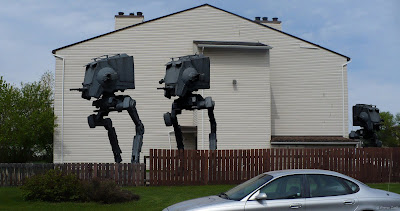
Here is a new label series that I like to call Pictures of Home. This will be a series of images posted over time of photograph's I have taken in and around my home and neighbourhood. After a long busy day of killing Rebel Scum it is good to know the AT-ST will get you home safely. Just watch out for rolling logs and furry midgets. They can really bump your insurance rate to a higher bracket and hurt your credit rating.
Images of the model can be seen here.
Focke Wulf 190 A-8 Composite
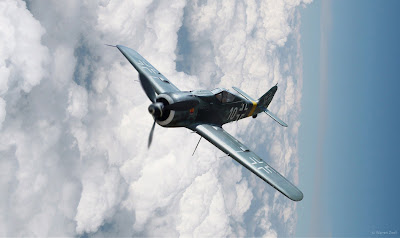
Here is my composite image of Hasegawa's 1/32 scale Focke Wulf 190 A-8 against a cloudy blue sky.
Images of the model can be seen here.
Wednesday, May 16, 2012
Focke Wulf FW 190 A-8
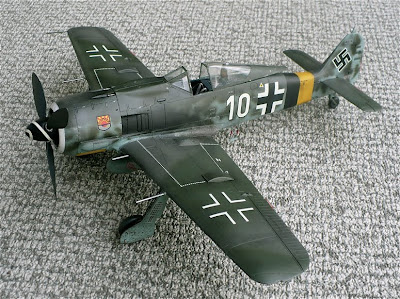
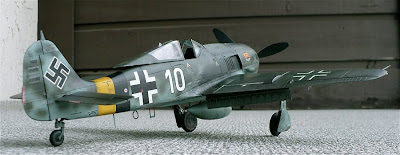

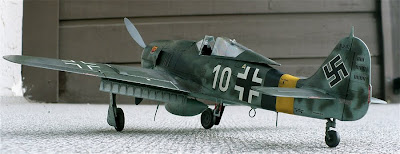
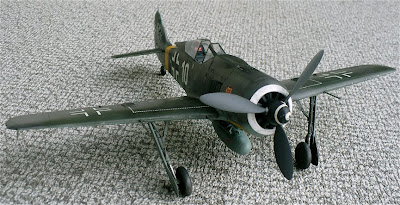

Here are some images of Hasegawa's 1/32 scale Focke Wulf Fw 190 A-8 (new tool).
Though I love the new tooling on this kit, the old kit came with interior engine and gun detail.
Why they didn't transfer this over to the new tooling is anyone's guess.
From Wikipedia"
The Fw 190 A-8 entered production in February 1944, powered either by the standard BMW 801 D-2 or the 801Q (also known as 801TU). The 801Q/TU, with the "T" signifying a Triebwerksanlage unitized powerplant installation, was a standard 801D with improved, thicker armour on the front annular cowling, which also incorporated the oil tank, upgraded from 6 mm (.24 in) on earlier models to 10 mm (.39 in). Changes introduced in the Fw 190 A-8 also included the C3-injection Erhöhte Notleistung emergency boost system to the fighter variant of the Fw 190 A (a similar system with less power had been fitted to some earlier Jabo variants of the 190 A), raising power to 1,980 PS (1,953 hp, 1,456 kW) for a short time. The Erhöhte Notleistung system operated by spraying additional fuel into the fuel/air mix, cooling it and allowing higher boost pressures to be run, but at the cost of much higher fuel consumption. From the A-8 on, Fw 190s could be fitted with a new paddle-bladed wooden propeller, easily identified by its wide blades with curved tips. A new outwardly bulged main canopy glazing format, more in the manner of a Malcolm hood rather than a bubble canopy, with greatly improved vision sideways and forward, had been developed for the F-2 ground attack model, but was often seen fitted at random on A-8s, F-8s and G-8s. The new canopy included a larger piece of head armour which was supported by reinforced bracing and a large fairing. A new internal fuel tank with a capacity of 115 L (30 US gal) was fitted behind the cockpit, which meant that the radio equipment had to be moved forward to just behind the pilot. Externally, a large round hatch was incorporated into the lower fuselage to enable the new tank to be installed, and the pilot's oxygen bottles were moved aft and positioned around this hatch. A fuel filler was added to the port side, below the rear canopy and a rectangular radio access hatch was added to starboard. Other changes included an ETC 501 underfuselage rack which was mounted on a lengthened carrier and moved 200 mm (8 in) further forward to help restore the centre of gravity of the aircraft. This fuselage would form the basis for all later variants of the Fw 190 and the Ta 152 series. The Morane "whip" aerial for the Y-Verfahren was fitted as standard under the port wing, just aft of the wheelwell. Nearly a dozen Rüstsätze kits were made available for the A-8, including the famous A-8/R2 and A-8/R8 Sturmbock models. The A-8/R2 replaced the outer wing 20 mm cannon with a 30 mm (1.18 in) MK 108 cannon. The A-8/R8 was similar, but fitted with heavy armour including 30 mm (1.18 in) canopy and windscreen armour and 5 mm ( in) cockpit armour. The A-8 was the most numerous of the Fw 190 As, with over 6,550 A-8 airframes produced from March 1944 to May 1945. A-8s were produced by at least eight factories during its lifetime.
Monday, May 14, 2012
de Havilland Mosquito NF MkII Night Fighter Composite
Images of the model can be seen here.
















